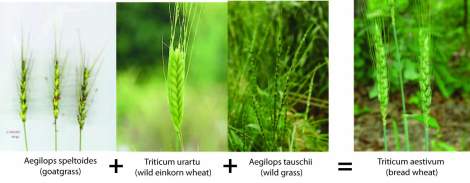In my books, nothing can quite compare to the irresistible smell of fresh bread rising in the oven or bread maker. Although I know that bread comes from wheat, I had never really given much thought to the evolutionary origins of this globally consumed crop.
Bread wheat, a species known as Triticum aestivum, has 6 genomes (2 copies each of 3 different genomes)! In comparison, humans have 2 copies of our genome; one we inherited from our mother and the other from our father. How come bread wheat has 6? It turns out that plants have a unique ability to carry multiple genomes; a phenomenon known as being polyploid.
Goatgrass (Aegilops speltoides) and the wild einkorn wheat (Triticum urartu) each contributed one pair of genomes to create a hybrid wheat which has been cultivated by humans. Then 8000 years ago a second fusion occurred between this cultivated wheat and a wild grass (Aegilops tauschii) to create what we recognize as bread wheat. Although these fusion events lead to improvements, such as allowing wheat to survive in colder climates, we really do not understand all the subtle contributions each genome has made to enabling global cultivation of bread wheat. Traditionally, organisms that contain multiple genomes are difficult to study. Understanding each bread wheat genome will allow us to continue to make improvements to wheat quality and to create environmentally resilient plants.

Images acquired from: http://www.missouriplants.com,en.wikipedia.com, http://www.ubio.org and http://www.flickr.com
Two papers were published this week from the Institute of Crop Science (Jia, J. et al 2013. Nature, 496:91-95) and the Chinese Academy of Sciences (Ling, H.Q. et al 2013. Nature, 496: 87-90) in Beijing, China which sequenced the genomes of the wild einkorn wheat and the wild grass whose fusion aided in creating bread wheat.
When authors examined the genomes they found that both wheat precursors were rich in genes for disease resistance. The goatgrass additionally had many genes for responding to stress such as toxins and cold temperatures. There were also genes that enabled this plant to survive in soil that is low in nutrients such as phosphate. The goatgrass also contributed many genes that enabled modern bread wheat to form elastic dough such as glutenin molecules, grain texture proteins and storage proteins. Researchers found that there was an expansion in the size of both genomes that occurred about 3-4 million years ago coinciding with a sudden climate shift.
One of the advantages of having sequenced the multiple genomes found in bread wheat is that they can search for, and potentially modify, genes of interest. For example, researchers were able to locate a gene in the wild einkorn wheat genome that controls grain length and weight; discovering that natural variations in this gene are associated with improved yields of this crop.
Sequencing the cohort of genomes found in bread wheat as well as other food crops enables us to not only understand their evolutionary origins but also tweak and modify genes to create and select for plants with enhanced yields, increased nutritional value and the ability to grow in harsher climates.
